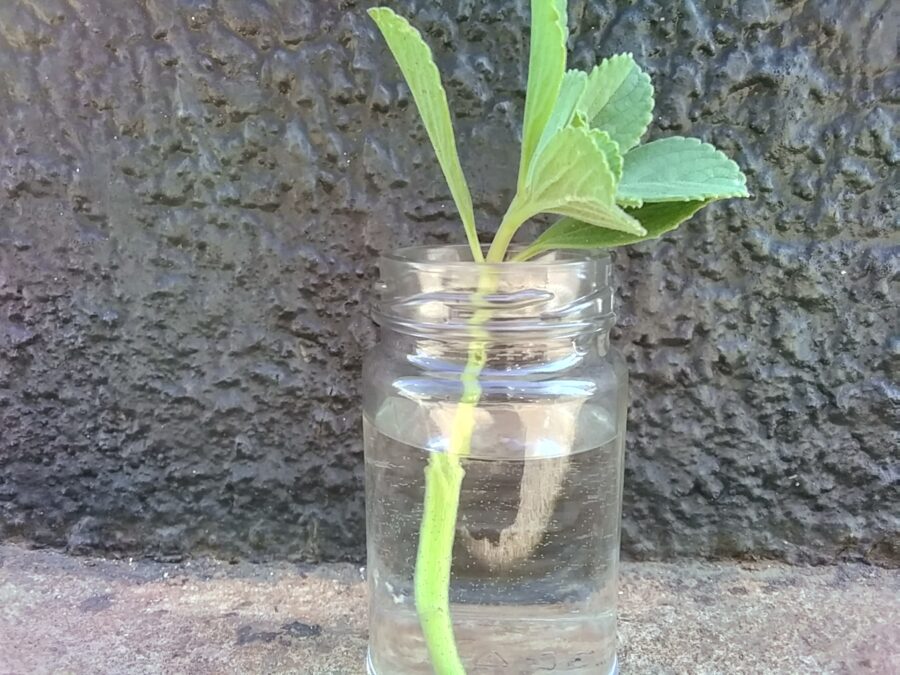Swedish ivies are beautiful succulent-like plants that produce thick fleshy leaves and grow really well in a hanging basket.
I’ve found the most effective way to care for Swedish Ivy growing inside my house is to grow it in well-draining soil, place it in a bright location away from direct sunlight, water it when the top soil feels dry to the touch, and trim any tall vines to encourage lively leaf growth.
If you want to keep your plant happy, carry on reading this post about how to grow and care for Swedish ivy plants indoors.
In this Article
General Info
Scientific name:
Plectranthus
Types
There are various species of this plant worldwide, but if you had to visit your local nursery, they might refer to them by their common name – Swedish Ivy.
They come in various sizes, shapes, and shades of green. The kind I’m growing is Cuban oregano. It’s coated with a thin layer of white, candle-like tomenta.
Here are a few other species of the plant.
- Plectranthus amboinicus ‘Cuban Oregano’ – It gives off a subtle oregano scent when you rub it between your fingers.
- Plectranthus tomentosus ‘Vicks plant‘- Produces attractive lilac flower stems and is believed to have healing properties. It’s often crushed and rubbed on the chest or steeped in hot water and drunk as a tea to clear congestion.
- Plectranthus argentatus ‘Silver Crest’ – The plant is well known for its silver foliage. During its blooming season – summer, it produces white or blue flowers.
- Plectranthus ecklonii ‘Large Spurflower’– An evergreen shrub that produces purple, aromatic flowers.
Common Names
- Creeping Charlie
- Swedish begonia
- Cuban Oregano
- Brazilian coleus
- Silvery plectranthus
- Candle Vine
- Vicks Plant
Optimal Hardiness Zones
9 to 13
Swedish Ivy Care Guide
Regardless of the variety you grow, they all have similar maintenance requirements. Carry on reading about the best ways to care for Swedish Ivy.
Soil
When introducing Swedish Ivy indoors, use well-draining soil as a planting medium. Some multipurpose or indoor potting mixes are slightly acidic, providing the optimum pH the plant needs to thrive.
If you don’t have potting soil, you can use a mixture of compost and garden soil. Compost plays a crucial role in:
- Reducing the density of the soil for adequate drainage,
- Providing essential nutrients.
- Increasing aeration.
The soil provides a stable structure for the plant and its roots. When using this method, I mix 20% compost with topsoil. This translates to one cup of compost to four cups of soil.
Water
Though Swedish ivy loves moist soil, damp, waterlogged soil often causes root rot, resulting in mold build-up indicated by yellow leaves. It’s best to water your Swedish Ivy when the topsoil feels dry. Ideally, water once every two weeks in summer and once a month in winter.
Fertilization
Swedish ivy is not a heavy feeder, so you don’t have to fertilize it often. A good rule of thumb is to fertilize once in spring with a soluble fertilizer to encourage beautiful foliage. Use a balanced fertilizer of 2:2:2, and follow the dosage instructions on the packaging.
I often use a slow-release fertilizer. This reduces overfeeding because the plant absorbs nutrients as and when needed.
Light Requirements
When growing Swedish Ivy indoors, ensure you provide enough bright light – not direct sunlight. So, place it on a table next to a window that receives indirect sunlight.
Pruning
Pruning is one of the most effective ways to produce a bushy plant. You can also use this technique to remove any diseased and withered leaves. I usually clip back any of the tall vines and plant healthy cuttings in my flower garden.
Propagating
If you don’t want to throw away any of the cuttings, propagating your Swedish ivy is often the better option. Propagation is best done in spring and summer because new leaves can continue growing from the nodes.
I started my Swedish Ivy in soil. I got stem cuttings from a friend and placed them directly in the soil. Within a couple of weeks, they were well established and new leaves started growing.
But, if you want to ensure your plant is developing healthy roots and surviving, you can start it in water. Because the roots can rot when there’s excess water, make sure you transfer it into the soil as soon as you notice signs of root development.
Here’s how to propagate your Swedish ivy.
What you’ll need:
- Swedish ivy cutting
- A glass jar filled with water
- Pruning shears or pair of scissors
Method
- Identify the creeping parts of the plant. Use pruning shears to cut off the stem and remove the lower leaves.
- Place the cutting in water
- Within two weeks you’ll notice root growth at the nodes
- Transplant the stem in the soil
Common Problems With Swedish Ivy
Swedish Ivy typically adjusts and flourishes in any conditions. But when neglected, it does become susceptible to disease. Here are some problems you might encounter with your houseplant and tips on how to deal with them.
Brown Spots

Brown spots are caused by bacterial growth due to over-watering. When Swedish ivy is left in soggy soil for long periods, there isn’t much oxygen available, resulting in root rot. You can treat root rot by removing the affected leaves and transferring the plant into fresh potting soil.
If there are affected leaves, cut them off with a clean knife or pruning shears. Spray the remainder of the leaves with bactericide or fungicide, and keep the plant in a well-ventilated area.
Yellowing Leaves
When your Swedish ivy is dry, its leaves can turn yellow. Remember, it appreciates moist soil, so increase the watering frequency based on your surrounding environment. Also, check up on the plant regularly to ensure the topsoil doesn’t dry out completely.
Frequently Asked Questions
If you have questions or concerns we haven’t covered, please leave them in the comments.
Is Swedish Ivy a good houseplant?
Swedish Ivy is a good house plant because it has minimal growing requirements.
It appreciates bright light away from direct sunlight, which is fantastic when growing it indoors because you can place it next to a window that receives indirect light. Because the plant loves moist soil, an indoor potting mix maintains moisture levels but does not leave the plant feeling overwatered.
How do you keep Swedish Ivy bushy?
You can keep Swedish Ivy bushy by trimming any of the long vines as soon as they start creeping toward the ground. If you want to grow more Swedish ivies, use the cutting to propagate new plants.
Does Swedish Ivy like being misted?
Swedish Ivy loves being hydrated but not waterlogged. Misting the plant every once a week helps to increase humidity levels and encourages dark green leaves.
Conclusion
Adding Swedish Ivy indoors makes a lovely addition to your hanging basket plants. It’s easy to care for, and you’ll soon find it can be a hands-off task when you have the required necessities taken care of. The plant loves well-drained, moist soil that doesn’t feel soggy and damp and appreciates bright light – promoting healthy foliage.
Because it’s not a heavy feeder, fertilize it once in spring using a slow-release fertilizer to absorb nutrients as and when needed. If you want to encourage new leaf growth, trim the long creeping vines and dead leaves. This way, the joints have enough room to reproduce more gorgeous Swedish Ivy leaves.
Are you growing Swedish Ivy inside your house and wondering how to better care for it? We’d love to answer any questions or concerns you have! Leave them in the comments section below.








